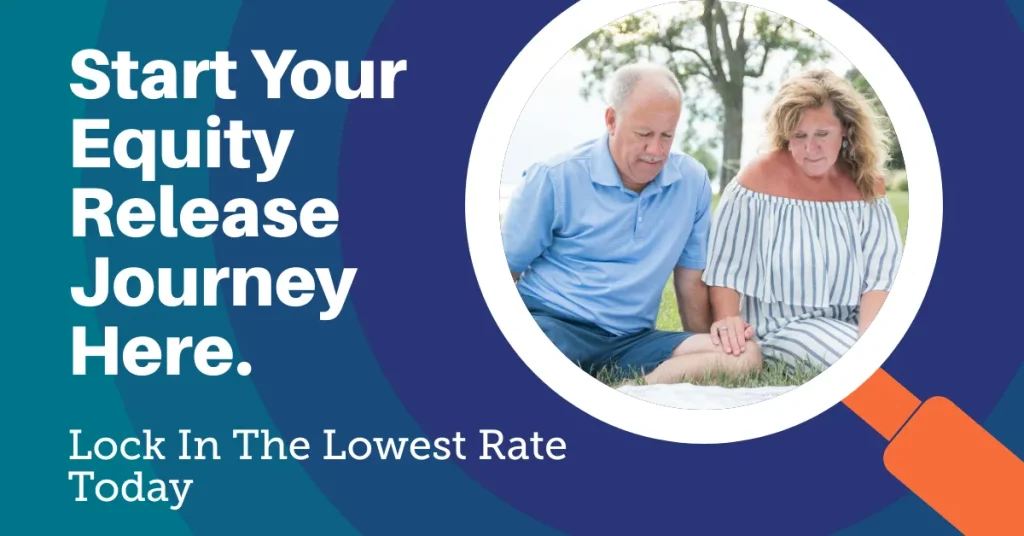Equity Release And Inheritance Tax 2025 Guide

Equity release can impact inheritance tax, as the money released from your home is included in the amount you owe. Your heirs may be liable for 40% of anything over a set allowance. It is essential to understand how equity release affects inheritance tax and what options are available to minimise it.
Equity release and inheritance tax are two important financial considerations for those approaching retirement age. Equity release can provide a way to access the wealth tied up in your property, but it’s essential to understand the potential impact on your inheritance tax liability. This guide will explore the basics of equity release and inheritance tax and how they relate to your financial planning.
By the end of this guide, you’ll better understand how equity release and inheritance tax work and the pros and cons of using equity release for inheritance tax planning.
Understanding Inheritance Tax
Inheritance tax is a tax levied on the estate of a deceased person. The estate includes all assets the person owns at the time of their death, such as property, investments, and personal possessions. Inheritance tax is calculated based on the estate’s value, and some thresholds and rates apply.
The current threshold for inheritance tax is £325,000. No inheritance tax is payable if the estate’s value exceeds this threshold. If the estate’s value is above the threshold, inheritance tax is payable at a rate of 40% on the amount above the threshold.
In addition to the threshold, there is also a residence nil rate band, introduced in 2017. This provides an additional threshold for inheritance tax for individuals who pass on their primary residence to their direct descendants. The current residence nil rate band is £175,000, meaning the total threshold for inheritance tax is £500,000 for individuals passing on their primary residence to direct descendants.
It’s important to note that inheritance tax is payable on the entire estate, not just the amount above the threshold. This means that if the estate is valued at £400,000, for example, inheritance tax would be payable on the entire £400,000, not just the £75,000 above the threshold.
Several strategies for reducing inheritance tax liabilities include making gifts during your lifetime, setting up trusts, and leaving assets to charity. It’s essential to seek professional financial advice to determine the best strategy for your circumstances.
Inheritance Tax Planning: Strategies to Reduce Your Tax Liability
Inheritance tax can be a significant burden on your estate, but there are several strategies you can use to reduce your tax liability. One of the most common strategies is to make gifts to your loved ones during your lifetime.
You can give away up to £3,000 per year without incurring any inheritance tax liability. Additionally, you can make small gifts of up to £250 to as many people as you like without incurring any tax liability.
Another strategy is to set up a trust. A trust is a legal arrangement where you transfer assets to a trustee, who manages them on behalf of the beneficiaries.
By setting up a trust, you can reduce the value of your estate and, therefore, reduce your inheritance tax liability. Several types of trusts are available, each with its benefits and drawbacks. 1st UK can help you determine the type of trust that best suits your needs.
It’s important to note that gifts made within seven years of your death may still be subject to inheritance tax. This is known as the seven-year rule. If you die within seven years of making a gift, the value of the gift will be added back to your estate for inheritance tax purposes.
In addition to gifts and trusts, there are other strategies you can use to reduce your inheritance tax liability. For example, you can use business relief or agricultural relief if you own a business or agricultural property. These reliefs can reduce the value of your estate and, therefore, reduce your inheritance tax liability.
Equity Release and Inheritance Tax
Equity release can be a valuable tool for mitigating inheritance tax liabilities. By releasing equity from your property, you can reduce the value of your estate and potentially reduce the amount of inheritance tax payable.
However, it’s essential to consider the tax planning implications of using equity release for inheritance tax planning. For example, if you release equity from your property and gift the money to your loved ones, this could be seen as a gift and be subject to inheritance tax.
Another consideration is the impact of equity release on your entitlement to means-tested benefits, such as pension credit and council tax reduction. Releasing equity from your property could affect your eligibility for these benefits, so it’s essential to understand the potential impact before making any decisions.
It’s also important to consider the risks associated with equity release. For example, if you take out a lifetime mortgage, the amount you owe could grow over time and exceed your property’s value.
This could mean no equity is left in your property to pass on to your loved ones.
Equity Release Schemes: Unlocking the Value of Your Property
Equity release is a popular way of unlocking the value of your property without having to sell it.
There are two main types of equity release schemes:
- Lifetime mortgages
- Home reversion plans

Lifetime Mortgages
A lifetime mortgage is a loan that is secured against your property. You can borrow a lump sum or receive regular payments, and the loan is repaid either when you die or when you sell your property. Interest is charged on the loan, which is added to the amount you owe.
One of the benefits of a lifetime mortgage is that you retain ownership of your property. This means that you can continue to benefit from any increase in its value.
However, it’s important to note that the interest on the loan can accumulate quickly, meaning that the amount owed can grow rapidly over time.
Example 1st UK Equity Release Plan
- Equity release at 5.16%.
- Free valuation fee
- No monthly payments unless you prefer interest-only
- Continue to live in your home and retain 100% ownership
- You can still move home as this Equity Release plan is transferable
Home Reversion Plans
A home reversion plan involves selling a percentage of your property to a provider in exchange for a lump sum or regular payments. You can continue living in your property rent-free, but you will no longer own the percentage you have sold.
One of the benefits of a home reversion plan is that you can receive a lump sum or regular payments without having to take out a loan. However, it’s important to note that you will no longer own the percentage of your property that you have sold. This means that you won’t benefit from any increase in its value.
Eligibility for Equity Release
To be eligible for equity release, you must be over 55 and own your home. The amount you can release depends on your property’s value and age.
Risks and Considerations: What to Keep in Mind
Before using equity release for inheritance tax planning, it is essential to consider the risks and seek professional advice. The team at 1st UK are here to help with any preliminary questions you might have.
Here are some of the risks associated with equity release:
Risk of Negative Equity
The amount you owe could grow over time and exceed your property’s value. This means that when you die or sell your property, the amount owed could exceed the sale price, leaving nothing for your beneficiaries.
Impact on Means-Tested Benefits
Equity release could affect your entitlement to means-tested benefits, such as pension credits and council tax reductions. This is because the money released from equity release is counted as capital and could affect your eligibility for these benefits.
Impact on Future Property Moves
Equity release could affect your ability to move to a different property in the future. This is because the loan or lump sum received from equity release is secured against your property, meaning it must be repaid when you die or sell it.
Costs Associated with Equity Release
It is also essential to consider the costs associated with equity release, such as arrangement, valuation, and legal fees. These fees can be expensive and impact the money you receive from equity release.
Case Study: How Equity Release Can Help Mitigate Inheritance Tax Liabilities
Mike and his wife Jo were both retired and owned a property worth £800,000. They had two children and wanted to leave their estate to them. However, they were concerned about the amount of inheritance tax that would be payable.
To mitigate their inheritance tax liabilities, John and his wife decided to release £200,000 of equity from their property and give the money to their children as a gift. At the time, John and his wife were both in good health and expected to live for many more years.
However, a few years later, John’s wife passed away unexpectedly. John was left with a large inheritance tax bill, as the value of his estate was now above the threshold. Fortunately, John had taken out a lifetime mortgage when he released equity from his property.
This meant that he had access to additional funds that he could use to pay the inheritance tax bill. He was able to repay the loan when he eventually sold the property. This case study highlights the importance of considering the risks associated with equity release, such as the potential for the amount owed to grow over time.
It also shows how equity release can be helpful for inheritance tax planning. If you’re considering equity release, it’s essential to understand the potential impact on your inheritance tax liability and explore alternative options.
Equity Release and Inheritance Tax
Equity release and inheritance tax are two crucial concepts in finance. Understanding how these two concepts relate, you can plan your finances effectively and reduce your inheritance tax liabilities.
Equity release and Santander Lifetime Mortgages can be valuable tools for inheritance tax planning, but it’s essential to consider the risks and seek professional advice before making any decisions. A financial advisor can help you understand the potential impact on your inheritance tax liability and explore alternative options.
With careful planning and consideration, you can use equity release to achieve your financial goals and secure your legacy for future generations.
Equity Release Inheritance Tax Planning FAQs
Who is eligible for equity release?
Homeowners aged 55 and over with a property worth at least £70,000.
What is the maximum amount I can release?
The amount you can release depends on your age, health, and the value of your property.
How can I reduce my inheritance tax liability with equity release?
You can use equity release to gift money to your loved ones during your lifetime, reducing the value of your estate.
What if I change my mind after taking out the equity release?
Most equity release schemes offer a no-negative-equity guarantee, meaning you won’t owe more than the value of your property.
UK Equity Release And Inheritance Tax and the likely Labour government
It could be very wise to consider equity release and inheritance tax as taxes are a waste of money. You could also consider downsizing and looking at the cheapest areas to buy in London and gifting cash long before you die.



